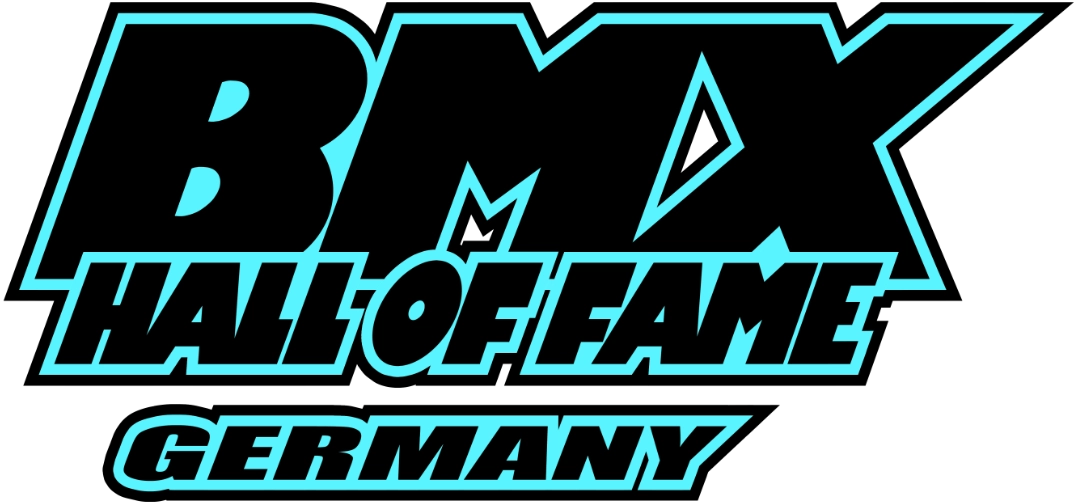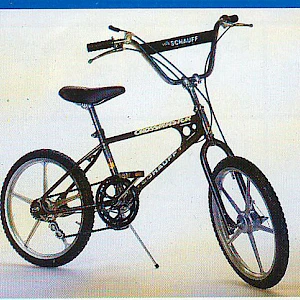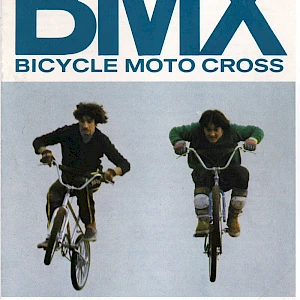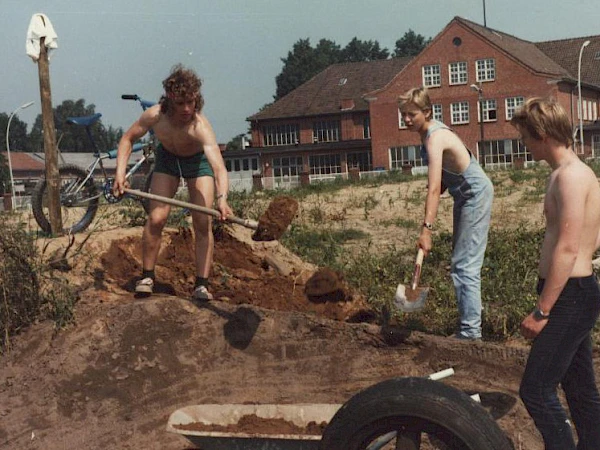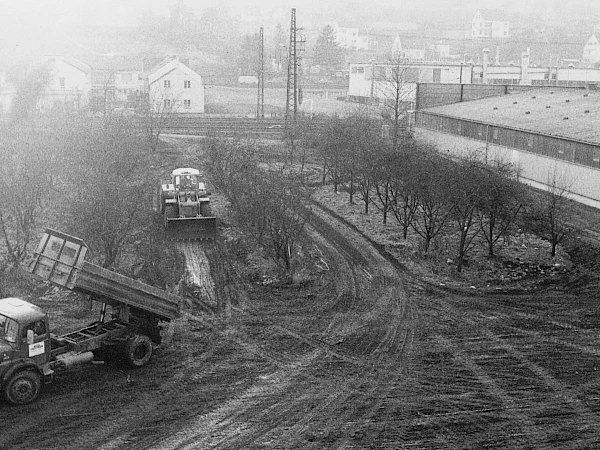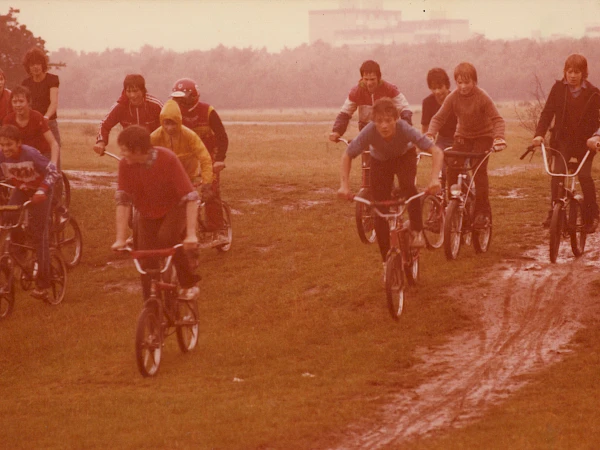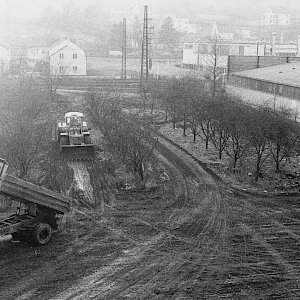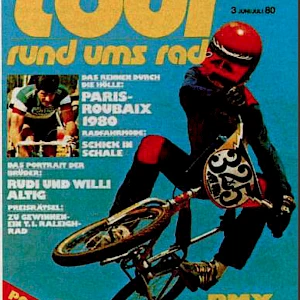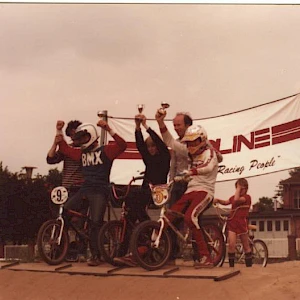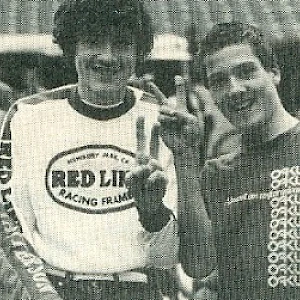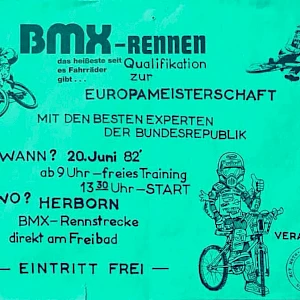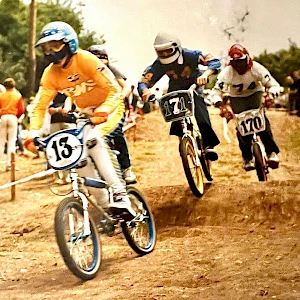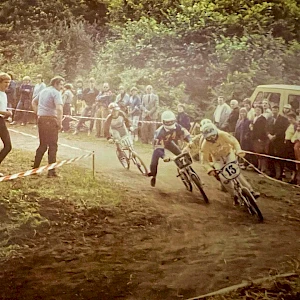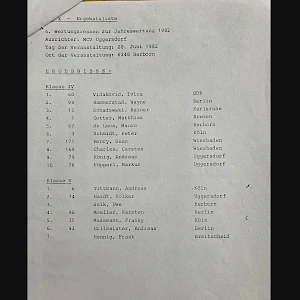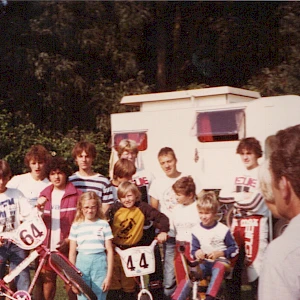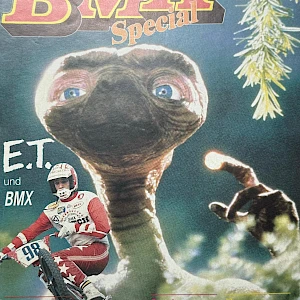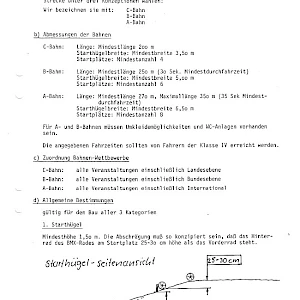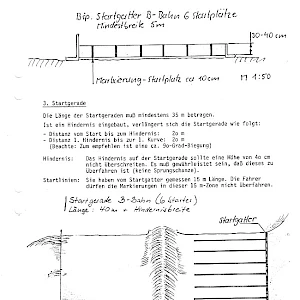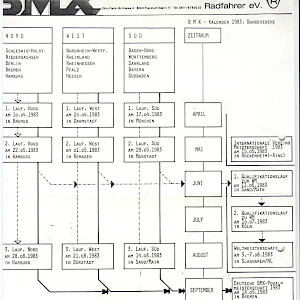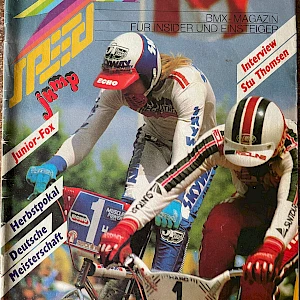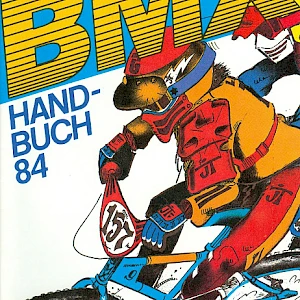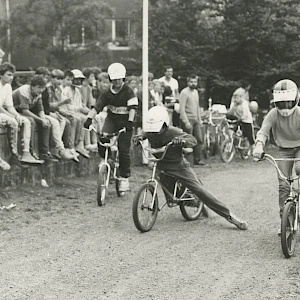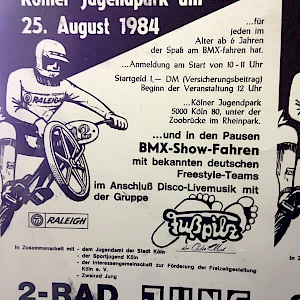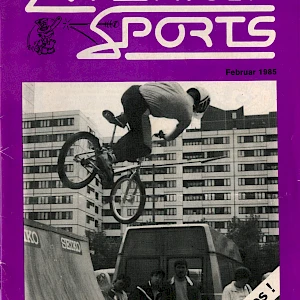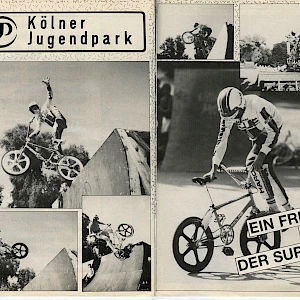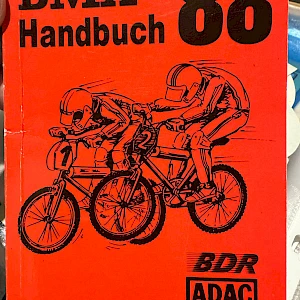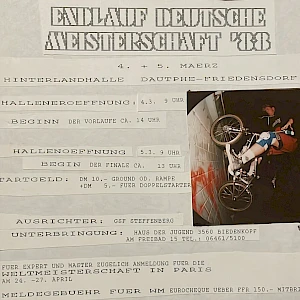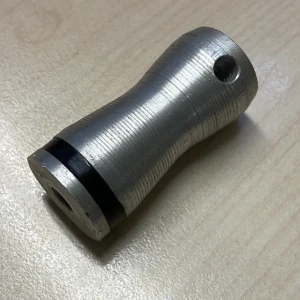Eine kurze Geschichte des BMX-Sports in Deutschland (WIP)
BMX entstand Ende der 60er in den Sandbergen zwischen Los Angeles und San Diego und kam 1978 über Frankreich und den Niederlanden nach Europa. Aber wie begann es in Deutschland? Im Folgenden versuchen wir, die Geschichte ein wenig aufzurollen.
1974

- Hans Schauff entwickelt die ersten Prototypen des Schauff BMX Rades, eine Mischung aus Highriser/Bonanzarad und BMX. Allerdings nur für den amerikanischen Markt
1977
- Für den Skateshop Blue Diamond in Köln baute Schauff 50 BMX Räder - der erste deutsche Kunde. Auf dem ersten Schauff-BMX Prospekt waren die beiden Kölner Max Victoria und Nao Tajima von Blue Diamond zu sehen.
1980
- 17 March, first contact between Ekkehardt Teichreber and Gerrit Does, who has been organising BMX races in the Netherlands since 1978. Teichreber then starts to get BMX parts from the Netherlands for his shop in Bremen.
- 19th March, Gerrit meets in Eindhoven with "7. Sinn" inventor Alfred Noell from the company "Cine Relations", who is researching the subject of BMX on behalf of the german public TV station ZDF.
- 29 March, Gerrit meets with Mr Ortgies and Mr Kynast at the Kynast headquarters to discuss the production of BMX bikes. The result is the BMX 2000.
- 3 June,"Tour - Rund ums Rad" reports on BMX in an article entitled "Cross-Craze in USA"
- Inspired by the American "Action Now" magazine, BMX scenes emerge in Frankfurt am Main, (West) Berlin and Cologne at the local roller skate and skateboard hotspots.
- Initiated by Ekkehardt Teichreber, the construction of the BMX track in Bremen-Grohn begins.
- The Blue Diamond skate shop organises the first races on a military training ground on the outskirts of Cologne. There is a mass start and the track consists of two straights and one bend. At the start: Uli Heidkamp and Andreas Tittmann
- Construction of the "Golden Mile" BMX track in Remagen behind the Schauff factory begins.
- The "Bund Deutscher Velo-Crossfahrer" is founded by Kurt Hammer (BDVC). Hammer is the general importer of Puch motorbikes and meets with G. Does in Waalre at the beginning of the year to find out about the organisation of BMX races. The BDVC has an office in Frankfurt am Main and consists of Kurt's son Rolf Hammer, Mr Schaffer and Mr Zweko, Ilse Gneissel, Walter Blum and Albert Waldman. The new association has enough financial backing and holds an extremely professional press conference to mark its foundation.
- Hartwig Hofherr 's skateshop "Hajo's" in Frankfurt adds BMX to its programme.
- Wolfgang Renner contacts Gerrit Does' brother-in-law Pierre Karsmakers, who had started importing BMX parts to the Netherlands in the seventies. Renner then enters the BMX business, with parts coming to Germany via Karsmakers.
1981
- Ekkehardt Teichreber veranstaltet zusammen mit seinem Mitarbeiter Jean-Pierre Clement das erste deutschlandweite BMX Rennen in Bremen-Grohn. Mit am Start: Jan Klostermann, Fred Rennemüller, Michael Leuner, Kai Jesse, Uli Heidkamp, Andreas Tittmann, Reinhard Liebert und einige mehr. Auch Hartwig Hofherr reiste extra aus Frankfurt an.
- 1. August, Uli Heidkamp und Andreas Tittmann starten bei dem AVRO TV Rennen in Waalre, Holland
- "Tour - Rund ums Rad" berichtet zum zweiten Mal über BMX. Als Organisatoren werden Wolfgang Renner, Ekkehardt Teichreber, Hartwig Hofherr und Karl Stuhle genannt
- Der "Centurion Super Cup" wird von Ekkehardt Teichreber und Wolfgang Renner organisiert. Er besteht aus Rennen in Bremen und Magstadt.
- 1. Juli, der Vegesacker BMX Club wird gegründet
- Uli Heidkamp, Andreas Tittmann und Willi Zims fliegen zum International BMX Championship im Ponitiac Silverdome, Michigan.
- Jeden ersten Sonntag im Monat finden in Remagen auf der Golden Mile BMX Rennen statt. 1983 wurden bis zu 800 Starter gemeldet. Die Anfänger Rennen waren Lizenz-offen, es gab auch reichlich Leihräder.
- 10. August, die IBMXF kontaktiert den BDR und informiert sie über die Aktivitäten des BDVC. Dem BDR wurde eine Zusammenarbeit nahe gelegt. Kurz darauf trafen sich die fünf Organisatoren des BDVC mit dem BDR, doch diese hatten wenig Vertrauen in die Funktionäre des deutschen Radsportverbandes. Nur vier Tage später ging ein Brief von Walter Hupel bei der IBMXF ein, der das Engagement des BDR im BMX ankündigte und Wilfried Spronk, den Vizepräsidenten des BDR, als BMX-Koordinator vorstellte. Hupel besuchte daraufhin ein Rennen in Assen, NL und versichert der IBMXF, dass sie mit dem BDVC und der IBMX zusammenarbeiten würden. Als der BDR allerdings zum Ende des Jahres sein Engagement im BMX offiziell bekannt gab, fehlte von den fünf Gründern des BDVC jede Spur – sie wurden nie wieder vom BDR kontaktiert und ihre schon vorhandene Expertise wurde ignoriert. Der BDVC stellte daraufhin den Betrieb ein.
1982
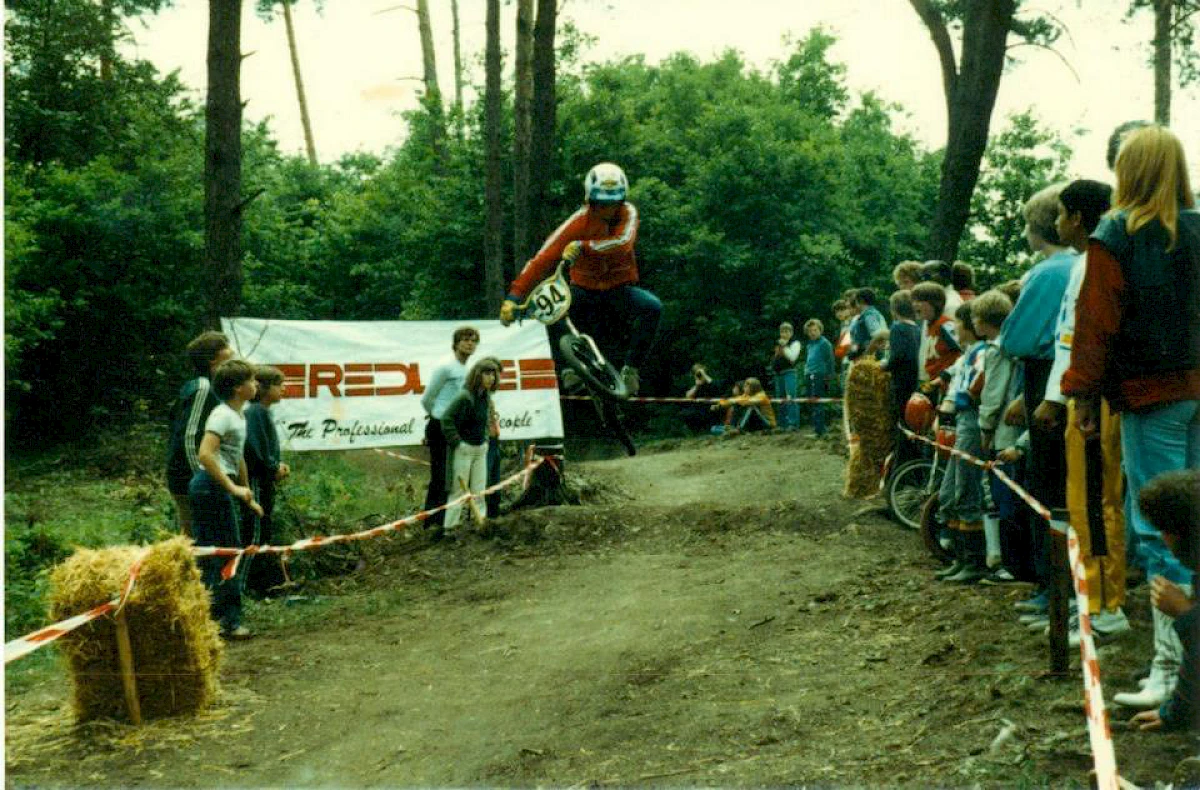
- From 6 January, BMX is officially part of the BDR. The BDR magazine "Radsport" talks about "BMX fever"
- The first official BMX race of the BDR starts on 24 April 1982 in Bremen and it is not only the first race of the German Championship but also the first qualifying race for the European Championship.
- A further 8 races were organised that year: Magstadt, Remagen, Baunach, Herborn, Sand Am Main and Darmstadt, where the Autumn Cup was held. The German champions of the year in the 5 age groups were crowned in Darmstadt.
- 17-18 July, the first IBMXF "open European Championship" takes place in Beek-en-Donk, NL. A German delegation of 14 riders is at the start.
- The BDR issues 330 licences according to its own information.
- At the IFMA trade fair in Cologne, Bob Haro puts on shows and introduces the new sport of "freestyle" to an astonished German audience.
- The first German BMX magazine"BMX Special" is launched under editor-in-chief Aris Donzelli
- ET is released in cinemas in December and triggers a Germany-wide BMX boom.
1983
- According to the BDR, there are now 20 tracks in Germany and around 1000 licensed riders. Around 300,000 BMX bikes were sold within a year (including department stores' bikes)
- 5-7 August, the IBMXF World Championships take place in Slagharen in the Netherlands. Holger Gassdorf and Johannes Brinkmann take fifth place in their classes (14 and 11 Junior respectively). Otherwise, the Germans come away empty-handed.
- On the initiative of Gerrit Does, a congress of all European BMX federations takes place in Darmstadt. Germany is represented by Wolfgang Renner, Heribert Blau (Markus Blau's father) and Walter Hupel
- The second German Championship starts in Bremen - this time in just one round. Eddie Fiola and Bob Morales ride shows.
- The editorial team of BMX Special leaves the publishing house in protest against another merger with the motocross enduro magazine and founds its own magazine,"Speed Jump", with its own publishing house. BMX Special is continued under editor-in-chief Rolf D. Meißner.
1984
- In the Netherlands, the "Amateur" class is created, which is then renamed "Superclass" in the course of the year.
- The BDR publishes its first manual and set of rules for BMX.
- Heribert Blau, Margarete Schmidtmann (the mother of Harald and Jan Klostermann), Wolfgang Renner, Willi Krug, Walter Hupel and Wilfried Spronk represent Germany in the IBMXF
- First endeavours to convert BMX racing into a competitive sport in which under-14s are excluded from European and World Championships.
- Jan van Eijden becomes German champion in class 2. Jan soon switches to track cycling and becomes Junior World Champion 1994 in the 1000 metre time trial.
- Gerrit Does proposes to the IBMXF to take up freestyle
- The Schauff Freestyle Team, consisting of Thomas Gerstmann and Björn Paetow, is the first German freestylers to attract attention. Thomas graces the cover of the April issue of BMX Special.
- BMX Special is cancelled and Speed Jump is the only remaining German BMX magazine. Rolf D. Meißner joins the magazine as the second permanent editor and the "Jump" in the name is dropped. From now on it is the"BMX Speed" magazine
- 21-22 July, Stefan Nüsser becomes European Champion in the Expert 12 class in Birmingham, UK
- The "Grand Prix BMX" takes place at the IFMA in Cologne. The name is a direct afront to the BDR/Speed racing series "Speed Grand Prix", which runs at the same time.
- A first letter is sent to the IOC with the proposal to make BMX an Olympic discipline
- André Maletz and Peter Beu organise the first competition in Cologne's Jugendpark. A race on wooden obstacles.
- The PTR trick team appears on the pages of "Speed" for the first time
1985
- The FIAC (Fédération Internationale Amateur de Cyclisme, a former sub-organisation of the UCI for amateur sport) includes BMX in its programme. It behaves arrogantly and patronisingly towards the IBMXF right from the start. The Secretary General of the FIAC, Carla Giuliani, says of BMX: "It's a children's toy, not a sport". Nevertheless, she claims full authority over BMX right from the start. Wolfgang Renner becomes part of a committee to discuss how the IBMXF should deal with the FIAC.
- 1-20 January, the first indoor race takes place in Hanover. The riders struggle with the angular obstacles and the slippery floor. Were you Team Coke or Team Hairspray on the tyres?
- In Berlin, Michael Müllmann and the skateboard and BMX dealer Schütze found the American Sports Magazine with a colourful mix of BMX racing/freestyle, skateboarding, American football and pig racing. The editorial team consists of Karsten Moeller and Andreas "Elle" Gillmeister and initially reports mainly from Berlin, but gradually expands its coverage over 10 issues.
- 9 - 11 August, Uwe Sturm takes second place in the Expert 15 class at the IBMXF World Championships in Whistler, Canada
- The FIAC also organises a World Championship in Pineta di Jesolo, Italy.
- In Speed, as part of a story about Chris Brown, it is announced that "ET returns" has been filmed. The release date should therefore not be long in coming.
- The first big freestyle contest takes place in Cologne's Jugendpark. The PTR trick team acts as a jury and puts on a show. Stephan Prantl and Frank Schnütgen share first place on the quarterpipe, while Bernd Schneider wins the floor competition.
- The GFA (German Freestyle Association) is also founded in Cologne by Freddy Schneider (RIP). It organises courses and freestyle contests.
- Together with BMX dealer Aretz, Speed organises a contest in Hennef to determine the German Skyway Team. The contest was initially organised in a strange "compulsory" format, where tricks were specified and then their execution was judged. However, this contest is only really remembered because the Hamburg team of Olaf Cavalcante, Michael Schütz and Hendrik Martz won in a very controversial decision. The latter was known throughout Germany at the time for his leading role in the TV Christmas series "Patrick Packard", where he once rode through the picture on a BMX bike. After this contest, the team barely made an appearance on the German contest scene.
1986
- First German Freestyle Championship takes place at the "Voets" car dealership in Braunschweig.
- The first Freestyle World Championship takes place in Vancouver, Canada. In this country, people only find out about it afterwards through magazines.
- 25 - 27 July, IBMXF European Championships in Weiterstadt with 1029 participants and over 7500 spectators, organised by TSV Braunshardt and Christiane Höpping. The "Tour" reports again.
- In September, the UCI announces in an article in BMX Plus! that BMX will be an Olympic sport from 1996. This turned out to be false. In reality, the president of the UCI, Hein Verbruggen, only announced in 2005 that BMX would be part of the 2008 Olympics in Beijing
- Another big IBMXF race took place at the IFMA
- In addition to the GFA, the "BMX Club Deutschland" is founded to organise freestyle contests. In addition to contests in Neustadt am Rbg and Düsseldorf, there is also a holiday camp in Gundelfingen, to which the American Skyway Team also travels.
- BMX Sport", as Speed is now called, is discontinued after only 4 issues. Germany is without a BMX magazine for the first time since 1982
1987
- Decade" from Bremen and "Boomerang" from Kassel are the first German BMX fanzines to be published.
- Second German Freestyle Championship at the "Voets" car dealership in Braunschweig.
- Second Freestyle World Championship in England in seven heats. Frank Schnütgen becomes world champion in 17+ Vert, Stephan Prantl second in 17+ Vert and Frank Rumohr third in 17+ Flat.
- In Bremen Huchting, the parents of successful racer Thorsten Dunkel, Christel and Volker, found the BMX Szene magazine. It runs for 10 issues until mid 1988.
1988
- Thomas Göring gründet in Karlsruhe mit seinem Bruder Wolfgang die Firma KHE Bikes. Das erste Produkt sind Pegs, die Thomas selber in seiner Wohnung auf einer kleinen Drehmaschine fertigt. Die Pegs sind ein riesiger Erfolg.
- Der Freestyle "Supercup", eine deutsche Meisterschaft in drei Läufen, wird ausgetragen im Köln Jugendpark, in Kenn bei Trier und Dautphe bei Marburg.
1990
- Die erste Freestyle WM auf deutschem Boden findet in Kenn bei Trier statt. Organisiert wurde sie von Thomas Grundheber bzw der DFO unter Mithilfe der IBMXFF / Geoff Catlow. Die Veranstaltung war ein riesiger Erfolg mit Teilnehmern aus vielen Ländern inklusive vieler namhafter Fahrer aus den USA.
1991
- Titus Dittmann launches the Monster BMX magazine. He appoints Robert Möller and Oliver Fuhrmann as editors-in-chief. Right from the start, the magazine tries to cover both racing and freestyle, although the focus quickly shifts to freestyle. Shortly afterwards, Michael Müllmann founds BMX Freestyle Magazine with Matt Pingel as editor-in-chief, meaning that BMX Germany suddenly has two magazines again. After unsuccessful attempts to merge the two magazines, Monster BMX is cancelled after just 6 issues, while BMX Freestyle makes it to spring 1993 and ceases publication after 8 issues.
1993
- Ralf Maier, Klaus Dyba and Kay Clauberg found Freedom BMX Magazine. Kay's children's room in Solingen initially served as the editorial office until they moved into their own office in 1996. The magazine still exists today - albeit only as a website.
